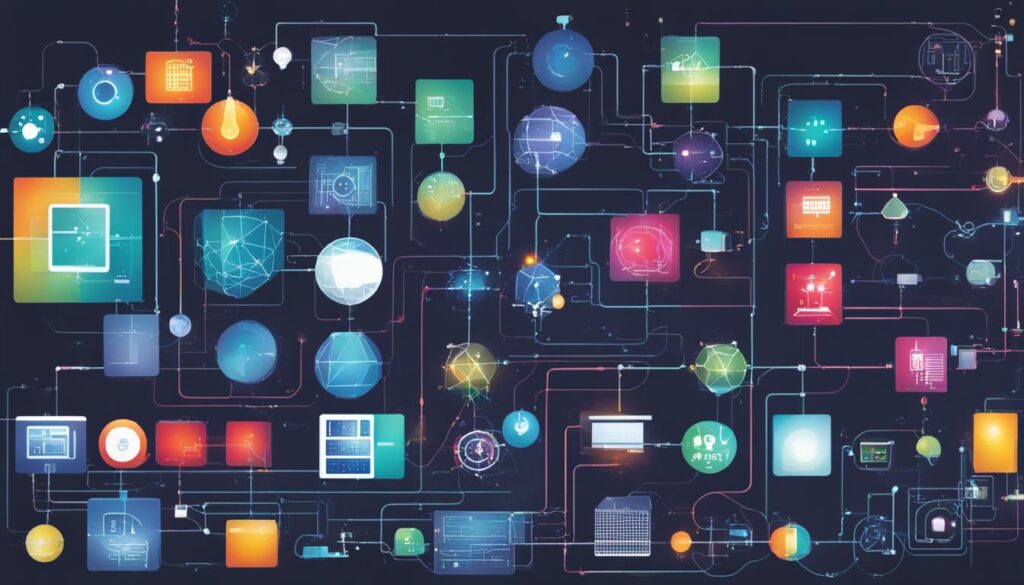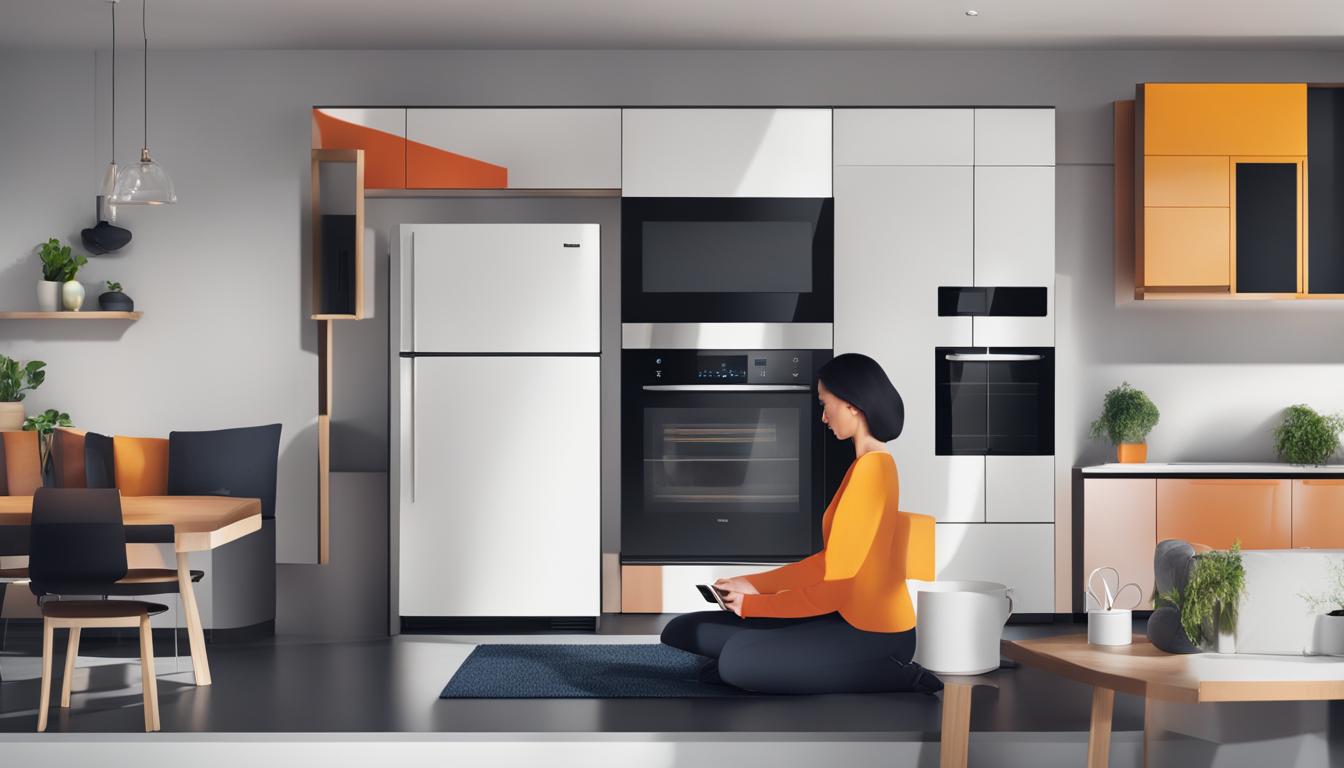Welcome to our article on understanding the differences between IoT sensors and traditional sensors. In today’s technologically advanced world, IoT (Internet of Things) has become a buzzword, but how exactly do IoT sensors differ from traditional sensors? Let’s explore the key distinctions and shed light on this intriguing topic.
IoT networks have revolutionized the way devices connect to the internet, providing valuable analytics and insights. In contrast, traditional networks consist of LAN, WLAN, WAN, and internet edge components. These fundamental differences set the stage for diverse functionalities between IoT sensors and traditional sensors.
Key Takeaways:
- IoT sensors offer greater deployment flexibility due to their ability to operate across different connectivity options.
- Traditional sensors are limited by their lack of built-in connectivity and advanced data processing capabilities.
- IoT sensors excel in data collection, analysis, and the ability to integrate with other systems.
- Traditional sensors have specific tasks and may lack innovation and integration capabilities.
- Understanding the differences between IoT sensors and traditional sensors is vital in navigating the evolving technological landscape.
IoT Sensor Features and Functionality
The evolution of IoT technology has revolutionized the way we interact with the world around us. IoT devices, also known as smart devices, are embedded with sensors, software, and connectivity capabilities that enable them to collect and exchange data over the internet. This advanced functionality offers numerous benefits and advantages, making IoT sensors a crucial component in various industries.
One of the key advantages of IoT sensors is their real-time monitoring capability. These sensors can continuously collect data from their surroundings, providing up-to-date information on various parameters such as temperature, humidity, pressure, and more. This real-time data enables organizations to make informed decisions and take immediate action when necessary. For example, in a manufacturing environment, IoT sensors can monitor machine performance and detect anomalies or potential failures, allowing for proactive maintenance and minimizing downtime.
Another significant feature of IoT sensors is automation. These devices can be programmed to perform actions based on predefined rules or triggers. For instance, in a smart home setup, IoT sensors can automatically adjust the temperature, lighting, and security settings based on the occupants’ preferences or detected presence. This automation not only enhances convenience but also improves energy efficiency and reduces costs.
Table: Comparison of IoT Sensor Advantages
| Advantages | IoT Sensors | Traditional Sensors |
|---|---|---|
| Connectivity | Connected to the internet for data exchange and remote control | Operate independently, limited to local data gathering |
| Data Analysis | Advanced data processing capabilities for real-time analysis | Basic data collection, limited analysis capabilities |
| Automation | Can be programmed to perform actions based on predefined rules | Manual operation, no automation capabilities |
| Integration | Can seamlessly integrate with other systems and platforms | Operate independently, limited integration options |
| Scalability | Can scale to accommodate a large number of devices and users | May have limitations in terms of scalability |
| Security | Require robust security measures due to potential cyber threats | Less susceptible to cyber attacks |
| Cost | Varies depending on features and capabilities | Generally less expensive |
Overall, IoT sensors offer a wide range of features and advantages that traditional sensors lack. From real-time monitoring to automation and integration capabilities, IoT sensors empower organizations and individuals to leverage data-driven insights and streamline operations. As the IoT ecosystem continues to grow and mature, the possibilities for innovation and efficiency are endless.
Traditional Sensor Characteristics and Limitations
Traditional sensors, unlike IoT sensors, have certain characteristics and limitations that differentiate them in terms of functionality and capabilities. These sensors are typically standalone devices that operate independently and do not have built-in connectivity or advanced data processing capabilities.
Traditional sensors are designed to perform specific tasks and have limited functionality compared to IoT sensors. They are often used in applications where basic data collection and measurement are sufficient. However, they may lack innovation and integration capabilities that IoT sensors offer.
One of the main advantages of traditional sensors is their cost-effectiveness. These sensors are generally less expensive compared to IoT sensors, making them a suitable option for applications with budget constraints. However, it’s important to note that traditional sensors may not have the same level of intelligence and energy-saving capabilities as IoT sensors.
Table: Comparison of Traditional Sensors and IoT Sensors
| Characteristics | Traditional Sensors | IoT Sensors |
|---|---|---|
| Connectivity | No built-in connectivity | Connected to the internet |
| Functionality | Limited | Advanced features and capabilities |
| Data Processing | Basic data collection | Advanced data analysis and processing |
| Integration | Lack of integration capabilities | Seamless integration with other systems |
| Scalability | May have limitations | Scalable to accommodate a large number of devices |
| Cost | Less expensive | Varies, depending on features and capabilities |
The table above provides a comparison between traditional sensors and IoT sensors in various aspects. It highlights the differences in connectivity, functionality, data processing, integration, scalability, and cost. These differences showcase how IoT sensors have a technological edge over traditional sensors, allowing for more advanced applications and enhanced capabilities.
Connectivity and Data Collection
The connectivity capabilities of IoT sensors enable them to gather and exchange data seamlessly across various devices and networks. These sensors utilize different connectivity options such as Wi-Fi, Bluetooth, Zigbee, or cellular networks, allowing them to communicate with other devices and the cloud. This connectivity flexibility greatly enhances their data collection capabilities.
IoT sensors excel in data collection and analysis, as they can gather information from multiple sensors and sources. They can collect real-time data, monitor environmental conditions, and track various parameters such as temperature, humidity, pressure, and more. This extensive data collection allows for in-depth analysis and insights, enabling businesses to make informed decisions and optimize their operations.

Automation and Control Features
In the world of IoT sensors, automation and control are key features that set them apart from traditional sensors. IoT devices incorporate advanced technologies such as sensors, actuators, and intelligent algorithms to enable automation and control in various applications. With these capabilities, IoT sensors can revolutionize industries and improve efficiency in ways that traditional sensors cannot.
IoT sensor automation refers to the ability of devices to perform tasks and make decisions without human intervention. Through the use of data collected from multiple sensors, IoT devices can analyze and interpret information to trigger actions or adjustments. For example, in a smart home system, IoT sensors can automatically adjust the temperature, lighting, and security settings based on occupancy and user preferences.
Similarly, IoT sensors offer control features that allow users to manage and interact with connected devices remotely. With the help of mobile apps or web interfaces, users can monitor and control IoT devices from anywhere. For instance, in industrial settings, IoT sensors can enable remote monitoring and control of machinery and equipment, reducing the need for manual intervention and improving operational efficiency.
These automation and control features of IoT sensors bring significant benefits to various sectors such as healthcare, agriculture, transportation, and manufacturing. They enhance productivity, optimize resource utilization, and improve overall user experience. By integrating automation and control capabilities, IoT sensors empower businesses and individuals with greater control and real-time responsiveness.
Table: Comparison of Automation and Control Features
| Features | IoT Sensors | Traditional Sensors |
|---|---|---|
| Automation | Automated tasks based on sensor data analysis | Manual operation and intervention required |
| Control | Remote monitoring and control through mobile apps or web interfaces | Limited control capabilities |
| Real-Time Responsiveness | Immediate response to changes in the environment | Static functionality |
As shown in the table, IoT sensors excel in automation, control, and real-time responsiveness compared to traditional sensors. This allows for efficient and optimized operations in various industries and brings convenience to users. The integration of advanced technology and connectivity in IoT sensors enables them to play a significant role in the era of smart devices and interconnected systems.
Integration and Scalability
One of the key advantages of IoT sensors is their ability to seamlessly integrate with other systems and platforms, allowing for cross-device communication and interoperability. This integration enables data sharing and collaboration between different devices, creating a cohesive network of interconnected devices. IoT sensors can connect with cloud platforms, data analytics tools, and other smart devices, enabling real-time data exchange and analysis.
Furthermore, IoT sensors offer scalability, meaning they can expand and accommodate a large number of devices and users. This scalability is crucial in today’s rapidly evolving technological landscape, where the number of connected devices continues to grow exponentially. Whether it’s in a smart home or an industrial setting, IoT sensors can adapt and scale to meet the increasing demands of a connected ecosystem.
Scalability also extends to the ability to handle large volumes of data. As IoT devices generate vast amounts of data, IoT sensors are equipped to manage and process this data efficiently. They can analyze incoming data, identify patterns and trends, and extract valuable insights in real-time. This scalability in data processing ensures that organizations can make informed decisions based on accurate and timely information.
Table: Comparison of IoT Sensor Integration and Scalability
| Aspect | IoT Sensors | Traditional Sensors |
|---|---|---|
| Integration | Seamless integration with other systems and platforms | Limited integration capabilities, operate independently |
| Scalability | Can accommodate a large number of devices and users, scalable data processing | Limited scalability, operate on a smaller scale |
| Data Management | Efficient data processing, real-time analysis | Limited data processing capabilities |
In summary, IoT sensors excel in integration and scalability. They can seamlessly integrate with various systems and platforms, enabling cross-device communication and collaboration. Additionally, IoT sensors offer scalability in terms of accommodating a large number of devices and users, as well as handling vast amounts of data. These capabilities make IoT sensors a powerful tool in the ever-expanding world of connected devices and intelligent systems.
Security and Cost Considerations
When comparing IoT sensors and traditional sensors, security is a crucial aspect to consider. IoT devices, being connected to the internet, are susceptible to cybersecurity threats. However, manufacturers are implementing robust security measures to protect these devices and the data they collect. It is important for organizations to prioritize security protocols and ensure that their IoT networks are protected against potential breaches.
In terms of cost, IoT sensors may have a higher initial investment compared to traditional sensors. This is primarily due to the advanced features, connectivity options, and data processing capabilities that IoT devices offer. However, it is important to consider the long-term benefits and cost savings that IoT sensors can provide. These devices offer greater efficiency, automation, and scalability, which can result in improved operational processes and cost optimization in the long run.
Ultimately, the decision between IoT sensors and traditional sensors depends on the specific needs and requirements of the organization. While traditional sensors may be more cost-effective initially, they may lack the advanced functionality and connectivity options that IoT sensors offer. It is crucial for organizations to carefully evaluate their security needs and budgetary considerations when choosing between IoT and traditional sensors for their applications.
Table: Comparison of IoT Sensor Security and Cost
| Aspect | IoT Sensor | Traditional Sensor |
|---|---|---|
| Security | IoT devices are susceptible to cybersecurity threats, but manufacturers implement security measures to protect them. | Traditional sensors are not connected to the internet and have lower cybersecurity risks. |
| Cost | Higher initial investment due to advanced features and connectivity options. | Lower initial cost but may lack advanced functionality and connectivity options. |
Conclusion
In conclusion, understanding IoT sensor technology and the key differences between IoT sensors and traditional sensors is crucial in today’s rapidly evolving technological landscape. IoT sensors, with their advanced connectivity, functionality, and data collection capabilities, offer a wide range of applications across various industries.
Unlike traditional sensors, IoT devices are embedded with sensors, software, and connectivity capabilities. They can collect and exchange data over the internet, providing real-time monitoring, automation, and control. IoT devices also excel in integration and scalability, seamlessly integrating with other systems and accommodating a large number of devices and users.
However, it’s important to consider the security and cost aspects. While IoT devices may be susceptible to cybersecurity threats, manufacturers are implementing security measures to protect them. The cost of IoT devices varies, but they offer advanced features and connectivity that traditional devices may lack.
Overall, IoT sensors have revolutionized the way we collect, analyze, and utilize data. With their innovative technology and extensive functionality, they have the potential to drive significant advancements in various industries, paving the way for a more connected and intelligent future.
FAQ
How do IoT sensors differ from traditional sensors?
IoT sensors have built-in connectivity and advanced data processing capabilities, allowing them to collect and exchange data over the internet. Traditional sensors, on the other hand, operate independently and do not have these connectivity and processing capabilities.
What are the advantages of IoT sensors?
IoT sensors offer advanced functionality such as real-time monitoring, automation, and control. They can seamlessly integrate with other systems and platforms, provide scalability, and gather information from various sensors and sources.
What are the characteristics of traditional sensors?
Traditional sensors have limited functionality, perform specific tasks, and lack built-in connectivity and advanced data processing capabilities. They may be less expensive but may not offer the same level of intelligence and energy-saving capabilities as IoT sensors.
How do IoT sensors collect data?
IoT sensors utilize various connectivity options such as Wi-Fi, Bluetooth, Zigbee, or cellular networks to exchange data with other devices and the cloud. They excel in data collection and analysis, gathering information from various sensors and sources.
Can IoT sensors automate tasks?
Yes, IoT sensors can automate tasks and respond to changes in the environment through the use of sensors, actuators, and intelligent algorithms. They offer automation and control features, whereas traditional sensors require manual operation.
How do IoT sensors integrate with other systems?
IoT sensors are designed to seamlessly integrate with other systems and platforms, allowing for cross-device communication and interoperability. They can scale to accommodate a large number of devices and users.
What are the security concerns with IoT sensors?
IoT sensors are susceptible to cybersecurity threats. However, manufacturers are implementing security measures to protect them and ensure data security. Traditional sensors may not have the same level of vulnerability to cybersecurity threats.
Are IoT sensors more expensive than traditional sensors?
The cost of IoT sensors varies depending on the specific device and its features. However, IoT sensors offer advanced features and connectivity that traditional sensors may lack, which can justify the higher cost in certain applications.
Source Links
- https://www.techtarget.com/searchnetworking/answer/Traditional-networks-vs-IoT-networks-Whats-the-difference
- https://arunraj444001.medium.com/what-are-the-differences-between-iot-devices-and-traditional-devices-3a0e4751c680
- https://www.automationworld.com/home/article/33001905/sensors-iots-central-nervous-system
 Skip to main content
Skip to main content


